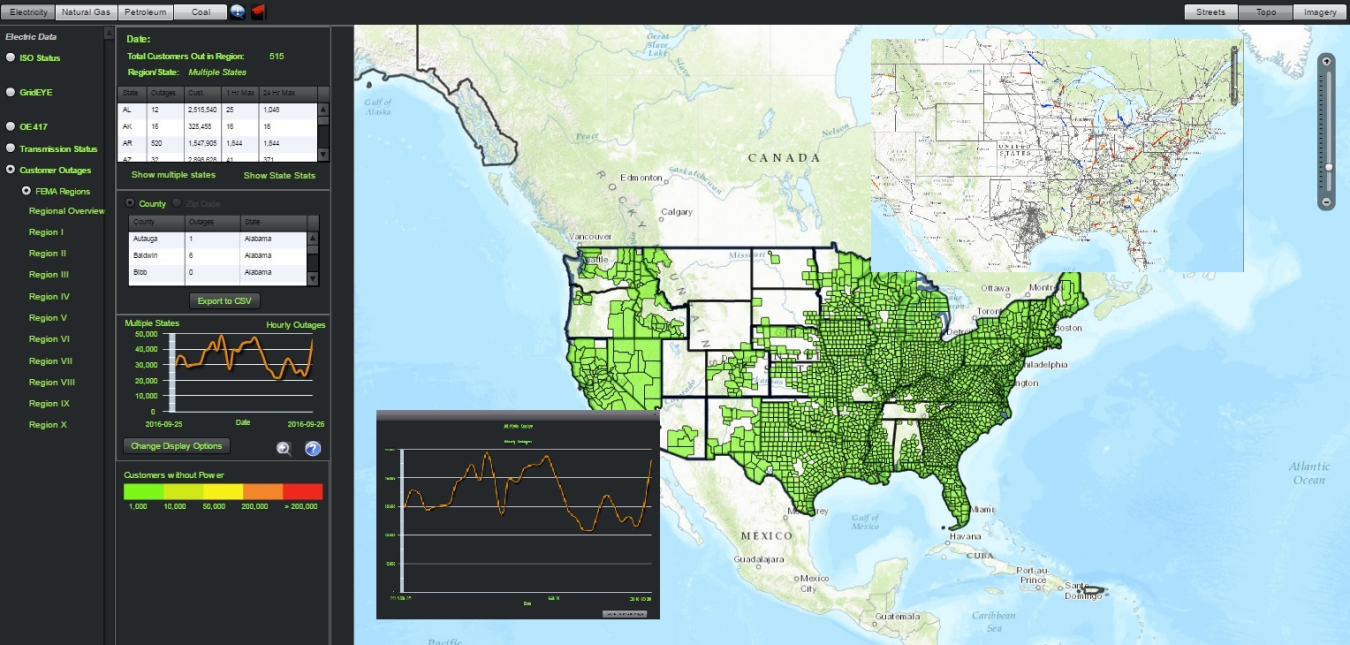
EAGLE-I’s National Outage Map tracks transmission line status and customer outage numbers by County, State, and FEMA Region.
The ability of the Nation to effectively respond to and facilitate the restoration of energy systems during disasters relies on the ability of local, state and federal government agencies, and private sector electricity and fuel providers to have access to timely, accurate, and actionable information about the status and potential impacts of energy sector disruptions. This information is currently provided by the U.S. Department of Energy (DOE) via its Environment for Analysis of Geo-Located Energy Information (EAGLE-I) system. This real time situational awareness tool for the Nation’s energy infrastructure was developed by the Office of Electricity Delivery and Energy Reliability’s (OE) Infrastructure Security and Energy Restoration (ISER) division. EAGLE-I provides capabilities for monitoring energy infrastructure assets, reporting energy outages, displaying potential threats to energy infrastructure, and coordinating emergency response and recovery. OE provides EAGLE-I as a service to other Federal, State, and local Agencies and Departments and to first-responders in accordance with DOE’s Emergency Support Function-12 (ESF-12) mission.
Today, DOE is announcing that it will transition EAGLE-I to a new infrastructure platform at Oak Ridge National Laboratory (ORNL), taking advantage of the laboratory’s world-class capabilities and expertise in energy infrastructure assurance and urban resilience utilizing geospatial data and analysis architectures, and scalable performance computing environments. The EAGLE-I transition was highlighted in the Administration’s announcement today of new Federal efforts to increase national preparedness. September is National Preparedness Month, a time when Americans and communities are encouraged to improve their ability to respond and recover from disasters and become more resilient.
Beginning with $3 million in FY16, ORNL will work with DOE, other Federal Agencies, and other DOE National Laboratories to develop the next generation of energy sector situational awareness capabilities and thus ensure that the EAGLE-I platform continues to serve as the Federal Government’s integration focal point for the historic and real-time collection, assimilation, integration, analysis, and dissemination of U.S. energy sector disruption data.
The EAGLE-I platform at ORNL will provide for collecting, analyzing, and sharing energy infrastructure information and integrating this with other complementary Federal and DOE Laboratory efforts. The EAGLE-I program’s expanded capabilities will support the integration and geospatial overlay of hazards for awareness of energy infrastructure assets at risk, including the electric grid, and petroleum, and natural gas infrastructures.
